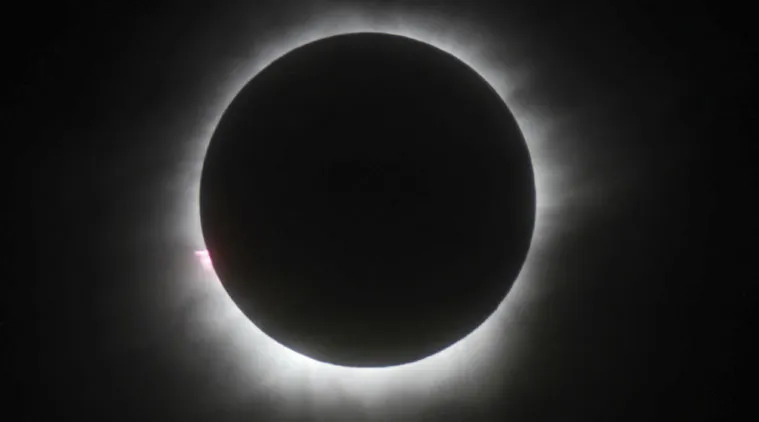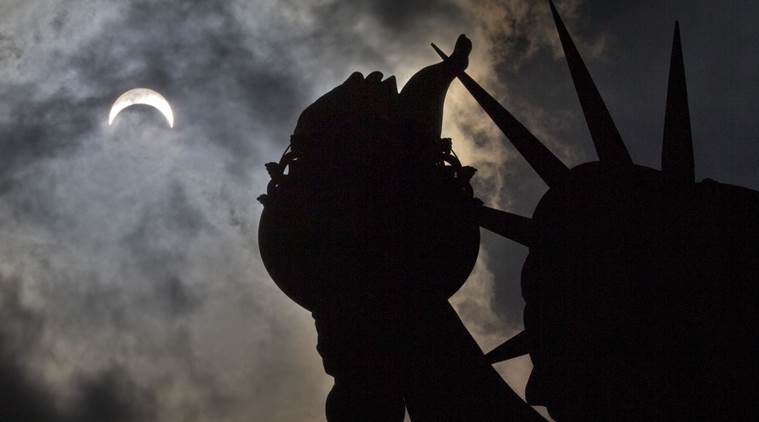Solar Eclipse 2017 LIVE: Rare full-blown eclipse turns day into night in US
Solar Eclipse 2017 LIVE UPDATES: A solar eclipse happens when the Moon moves between the Sun and Earth, blocking out the Sun's rays and casting a shadow on parts of Earth.
 Solar Eclipse 2017 LIVE: If you are in America on Monday, you might experience a total solar eclipse, if not, a partial one.
Solar Eclipse 2017 LIVE: If you are in America on Monday, you might experience a total solar eclipse, if not, a partial one.
The United States of America is witnessing a total solar eclipse for the first time in 99 years. The solar eclipse started around 1 p.m EDT (which is around 10.30 pm IST). A solar eclipse happens when the Moon moves between the Sun and Earth, blocking out the Sun’s rays and casting a shadow on parts of Earth. But this one is special because it is taking place across the entire United States, and thus people will actually be able to view this.
So, if you are in America on Monday, you might experience a total solar eclipse, if not, a partial one. But to witness this mega astronomical event one has to be careful and exercise caution. It is suggested that one should never watch directly at the sun during the eclipse. Also, one should always use either sunglasses or telescopes or a binocular or X-Ray plate to watch the solar eclipse to avoid damage to eyes.
Here are the LIVE UPDATES:
1.50 am: The total eclipse has ended in the US, but a partial solar eclipse will remain until 4:10 pm(ET)
Thanks for joining us to experience #Eclipse2017! Join us again in 2024! Check out our image gallery: https://t.co/lg7SdbOHwh pic.twitter.com/ToS124gcRO
— NASA (@NASA) August 21, 2017
1.40 am: Check out this Geocolor loop !
Watch the moon’s shadow move across the US in this geocolor loop from #GOES16! See more #SolarEclipse imagery @ https://t.co/1oNaGe1dLN pic.twitter.com/uJbEVQin6V
— NOAA Satellites (@NOAASatellites) August 21, 2017
1.23 am: The crickets and other animals grew noisy when it got darker at the Nashville zoo, but as the sun was totally blotted out, it was the humans who drowned out the animals, clapping, “oohing” and “aahing” for more than the nearly two minutes the total eclipse lasted, AP reports.
1.15 am: A partial solar eclipse appears over the Statue of Liberty on Liberty Island in New York, Monday. (AP Photo)

1.00 am: Check out how Solar Eclipse looks from space?
You probably saw #SolarEclipse2017 from Earth…but what did it look like from space? Check out these @Space_Station views: pic.twitter.com/6uPdyRFbXs
— NASA (@NASA) August 21, 2017
12.33 am: US Vice-President Mike Pence is watching the cosmic spectacle from the US Navy Observatory in Washington, DC.
Also watching #Eclipse2017 is @VP Pence from the @USNavy Observatory in Washington, DC. w/ NASA astronaut Pam Melroy & local students. pic.twitter.com/umWdPpNkuF
— NASA (@NASA) August 21, 2017
12.30 am: President Donald Trump and first lady Melania Trump wear protective glasses as they view the solar eclipse at the White House in Washington. (AP Photo)

12.15 am: A crowd gathers in front of the Hollywood sign at the Griffith Observatory to watch the solar eclipse in Los Angeles on Monday. (AP Photo)

12.07 am: A little warning for our American readers ! It is not advisable to look into the sun without protection, except when the sun is 100 percent covered. In order to avoid eye damage, you should use solar eyeglasses or pinhole projectors that can cast an image of the eclipse into a box.
12.00 am: Solar Eclipse has reached the path of totality in Kentucky.
11.47 pm: Watch ! Total Solar Eclipse underway in Nebraska.
Here’s #SolarEclipse2017 views of totality in Nebraska! Take a look here and watch our live show for more: https://t.co/cOKssim1bY pic.twitter.com/qFgqf3ZI2s
— NASA (@NASA) August 21, 2017
11.43 pm: “It’s really, really, really, really awesome,” said 9-year-old Cami Smith as she watched the fully eclipsed sun from a gravel lane near her grandfather’s home at Beverly Beach, Oregon: AP
11.30 pm: The moon is seen passing in front of the sun during a solar eclipse from Ross Lake, Northern Cascades National Park, in Washington on Monday. (Source: NASA via AP)

11.08 pm: The moon covers the sun during a total eclipse near Redmond, Oregon. (AP Photo)

10:53 pm: WATCH the first glimpse of Solar Eclipse totality in Oregon.
First glimpse of #SolarEclipse2017 totality in Oregon! Take a look here and watch our live stream for more: https://t.co/cOKssim1bY pic.twitter.com/g9zEbWFXfk
— NASA (@NASA) August 21, 2017
10.35 pm: Latest visual of the phenomenon from NASA.
The Moon is seen as it passes in front of the Sun during #Eclipse2017 from Northern Cascades National Park. Watch: https://t.co/OjWUZhRJ3p pic.twitter.com/XfL6RCdxTg
— NASA (@NASA) August 21, 2017
10.30 pm: A crowd wears protective glasses as they watch the beginning of the solar eclipse from Salem, Oregon. (Source: AP)

10.18 pm: Watch the live streaming of first full-blown solar eclipse to sweep the U.S. from coast to coast in nearly a century.
10.05 pm: It’s happening !
WATCH live the 2017 #SolarEclipse here: https://t.co/CrDLx7QwTS#SolarEclipse2017 pic.twitter.com/EEfiQFjFY3
— Stars and Stripes (@starsandstripes) August 21, 2017
10.00 pm: Solar Eclipse has begun over Oregon, the first place from where the phenomenon can be witnessed.
9.55 pm: Millions of Americans equipped with protective glasses across the United States are gearing up to witness the first total solar eclipse to unfold from coast to coast in nearly a century.
8.50 pm: Until the solar eclipse starts, you can read about top 20 funny memes ruling the internet in connection with the phenomenon here.
8.10 pm: Solar Eclipse is among the top trends on Google.

7.58 pm: The National Aeronautics and Space Administration (NASA) is all geared for the big event, as they said that it will provide “images captured before, during, and after the eclipse by 11 spacecraft, at least three NASA aircraft, more than 50 high-altitude balloons, and the astronauts aboard the International Space Station” all around the world.
7.50 pm: The last time an eclipse travelled across USA was in 1918 and the last time anyone in the United States witnessed a total solar eclipse was almost 40 years ago, on February 26, 1979.
7:43 pm NASA will have a live video stream from locations across the country and beyond. According to the NASA website, the live stream begins 1 pm EDT or around 9.50 PST on August 21, which is around 10.30 pm for India. The Solar Eclipse event will begin at this time, and NASA will have a live video stream for the same.
7:36 pm During the solar eclipse, a shadow will rush across the sky at 1,500 miles an hour, creating a cold spot that will ripple the atmosphere like a speedboat stirring up a bow wake.
7:30 pm: Solar Eclipse is among the top trends on Google and people are excited to know every minute details of the rare event.
Mapped: how America has been searching for #SolarEclipse17
LINK: https://t.co/YBkaVhldFX#dataviz pic.twitter.com/hqQgtDEbWv
— GoogleTrends (@GoogleTrends) August 21, 2017
7:00 pm: People across US have started tweeting about their excitement for the rare astronomical event.







